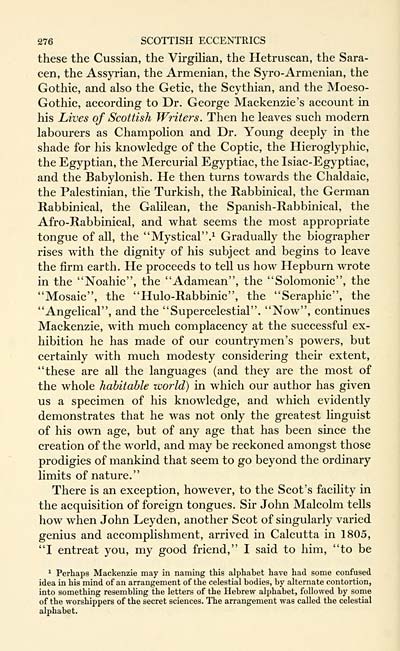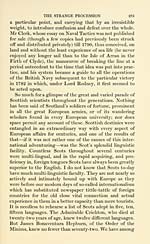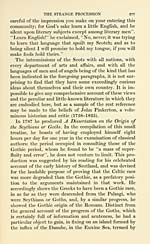Ossian Collection > Scottish eccentrics
(292)
Download files
Complete book:
Individual page:
Thumbnail gallery: Grid view | List view

276 SCOTTISH ECCENTRICS
these the Cussian, the Virgilian, the Hetruscan, the Sara-
cen, the Assyrian, the Armenian, the Syro- Armenian, the
Gothic, and also the Getic, the Scythian, and the Moeso-
Gothic, according to Dr. George Mackenzie's account in
his Lives of Scottish Writers. Then he leaves such modern
labourers as Champolion and Dr. Young deeply in the
shade for his knowledge of the Coptic, the Hieroglyphic,
the Egyptian, the Mercurial Egyptiac, the Isiac-Egyptiac,
and the Babylonish. He then turns towards the Chaldaic,
the Palestinian, the Turkish, the Rabbinical, the German
Rabbinical, the Galilean, the Spanish-Rabbinical, the
Afro-Rabbinical, and what seems the most appropriate
tongue of all, the "Mystical". 1 Gradually the biographer
rises with the dignity of his subject and begins to leave
the firm earth. He proceeds to tell us how Hepburn wrote
in the "Noahic", the "Adamean", the "Solomonic", the
"Mosaic", the "Hulo-Rabbinic", the "Seraphic", the
"Angelical", and the "Supercelestial". "Now", continues
Mackenzie, with much complacency at the successful ex-
hibition he has made of our countrymen's powers, but
certainly with much modesty considering their extent,
"these are all the languages (and they are the most of
the whole habitable world) in which our author has given
us a specimen of his knowledge, and which evidently
demonstrates that he was not only the greatest linguist
of his own age, but of any age that has been since the
creation of the world, and may be reckoned amongst those
prodigies of mankind that seem to go beyond the ordinary
limits of nature."
There is an exception, however, to the Scot's facility in
the acquisition of foreign tongues. Sir John Malcolm tells
how when John Leyden, another Scot of singularly varied
genius and accomplishment, arrived in Calcutta in 1805,
"I entreat you, my good friend," I said to him, "to be
1 Perhaps Mackenzie may in naming this alphabet have had some confused
idea in his mind of an arrangement of the celestial bodies, by alternate contortion,
into something resembling the letters of the Hebrew alphabet, followed by some
of the worshippers of the secret sciences. The arrangement was called the celestial
alphabet.
these the Cussian, the Virgilian, the Hetruscan, the Sara-
cen, the Assyrian, the Armenian, the Syro- Armenian, the
Gothic, and also the Getic, the Scythian, and the Moeso-
Gothic, according to Dr. George Mackenzie's account in
his Lives of Scottish Writers. Then he leaves such modern
labourers as Champolion and Dr. Young deeply in the
shade for his knowledge of the Coptic, the Hieroglyphic,
the Egyptian, the Mercurial Egyptiac, the Isiac-Egyptiac,
and the Babylonish. He then turns towards the Chaldaic,
the Palestinian, the Turkish, the Rabbinical, the German
Rabbinical, the Galilean, the Spanish-Rabbinical, the
Afro-Rabbinical, and what seems the most appropriate
tongue of all, the "Mystical". 1 Gradually the biographer
rises with the dignity of his subject and begins to leave
the firm earth. He proceeds to tell us how Hepburn wrote
in the "Noahic", the "Adamean", the "Solomonic", the
"Mosaic", the "Hulo-Rabbinic", the "Seraphic", the
"Angelical", and the "Supercelestial". "Now", continues
Mackenzie, with much complacency at the successful ex-
hibition he has made of our countrymen's powers, but
certainly with much modesty considering their extent,
"these are all the languages (and they are the most of
the whole habitable world) in which our author has given
us a specimen of his knowledge, and which evidently
demonstrates that he was not only the greatest linguist
of his own age, but of any age that has been since the
creation of the world, and may be reckoned amongst those
prodigies of mankind that seem to go beyond the ordinary
limits of nature."
There is an exception, however, to the Scot's facility in
the acquisition of foreign tongues. Sir John Malcolm tells
how when John Leyden, another Scot of singularly varied
genius and accomplishment, arrived in Calcutta in 1805,
"I entreat you, my good friend," I said to him, "to be
1 Perhaps Mackenzie may in naming this alphabet have had some confused
idea in his mind of an arrangement of the celestial bodies, by alternate contortion,
into something resembling the letters of the Hebrew alphabet, followed by some
of the worshippers of the secret sciences. The arrangement was called the celestial
alphabet.
Set display mode to: Large image | Transcription
Images and transcriptions on this page, including medium image downloads, may be used under the Creative Commons Attribution 4.0 International Licence unless otherwise stated. ![]()
| Early Gaelic Book Collections > Ossian Collection > Scottish eccentrics > (292) |
|---|
| Permanent URL | https://digital.nls.uk/81911848 |
|---|
| Description | Selected books from the Ossian Collection of 327 volumes, originally assembled by J. Norman Methven of Perth. Different editions and translations of James MacPherson's epic poem 'Ossian', some with a map of the 'Kingdom of Connor'. Also secondary material relating to Ossianic poetry and the Ossian controversy. |
|---|
| Description | Selected items from five 'Special and Named Printed Collections'. Includes books in Gaelic and other Celtic languages, works about the Gaels, their languages, literature, culture and history. |
|---|

